 Google pretty much owns the search landscape with over 90% of the global search market share. So, understanding how to get a great position on Google is important if you want your MSP site to get as much traffic as possible.
Google pretty much owns the search landscape with over 90% of the global search market share. So, understanding how to get a great position on Google is important if you want your MSP site to get as much traffic as possible.
One of the most coveted spots to gain is a “Featured Snippet,” which lists your page in a large box right at the top of the search results.
Are you doubting that your webpage could earn such a prestigious position? You may be surprised to know that you don’t have to be a large corporate page to do it. We’ll go through everything you need know!
Featured Snippets Basics
Let’s start with the basics of what featured snippets are and why they’re an important target to consider when posting content to your IT business website.
What is a featured snippet?
Featured snippets are those informational boxes of content that show up on the top of the page in Google for certain search results. They are designed to provide a quick and more complete answer to a query than the usual search results with just a few lines of text.
Featured snippets can show up for any type of search but are most likely to show up on searches in the form of a question.
A featured snippet includes more than the usual search result information. It has:
- About a paragraph of information from the page
- Link to the page
- Page title
- URL of the page
The type of information included in a featured snippet will vary. They will typically include one or more of the following:
- Paragraph of text
- Image
- List or set of steps
- Table
- Video
- Tool or calculator
Here is an example of a featured snippet and why getting one is like winning an Oscar for that particular search term.
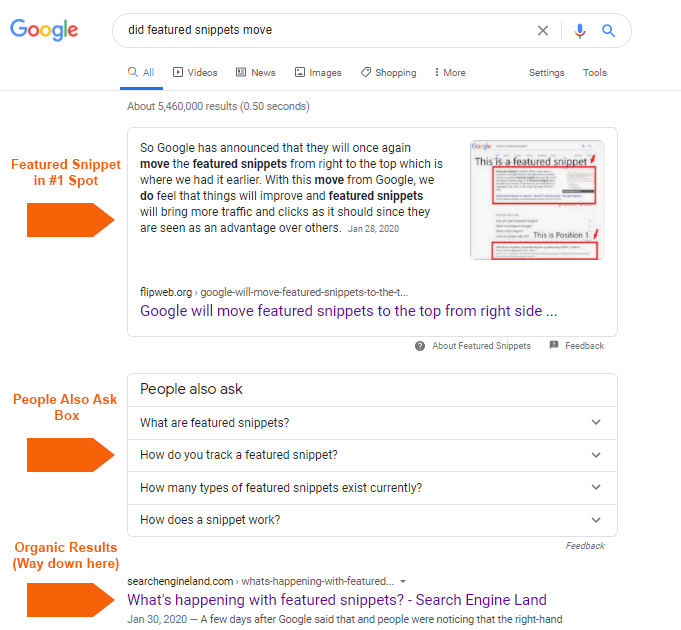
As you can see from the example, it’s getting harder to show up at the top of the page (above the fold) even if you have a high search position, like 1 to 5. Google keeps adding features to search designed to deliver the best information to the user, but these features can push down organic results.
After the featured snippet, you see the “People also ask” result, and both take up quite a bit of the top page space. This SERP doesn’t even have any paid ads, which further impact how far someone has to scroll before getting to the first organic result.
What’s the benefit of having your well-written blog or website page in a featured snippet?
- Average click-through rate increase of 114%
- You can leapfrog over competitors (70% of featured snippets come from outside the top ranking position)
- If you have the #1 organic position, a featured snippet can gain you 31% more traffic
Of course, there’s also the bragging rights of getting that big prestigious snippet box pointing directly to your website!
Now, let’s discuss what you can do to improve your chances of getting a featured snippet.
Tips for Positioning Your Page for a Featured Snippet
According to Google, there is nothing specific you can do to get a featured snippet. You can’t submit your site for one or request one.
This is what Google says about how it chooses featured snippets:
“Featured snippets come from web search listings. Google’s automated systems determine whether a page would make a good featured snippet to highlight for a specific search request.”
But like any other type of SEO, you can position your page to have a better chance at being chosen as a featured snippet. It basically takes:
- Well-written content
- SEO optimization on the page
- Featured snippet-friendly formatting
Anyone can rank for a coveted featured snippet spot on a search result. Even a local MSP business that is working hard to keep their tech marketing engine driving leads for them.
How do we know? Because our sister site, Tech Blog Builder had two of its client blogs show up in featured snippets (and there may be more out there!).
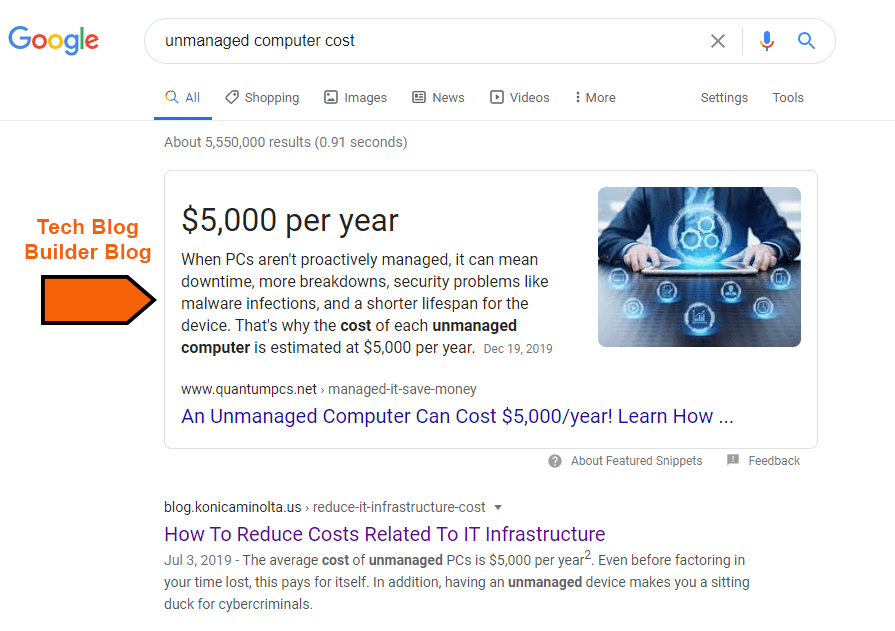
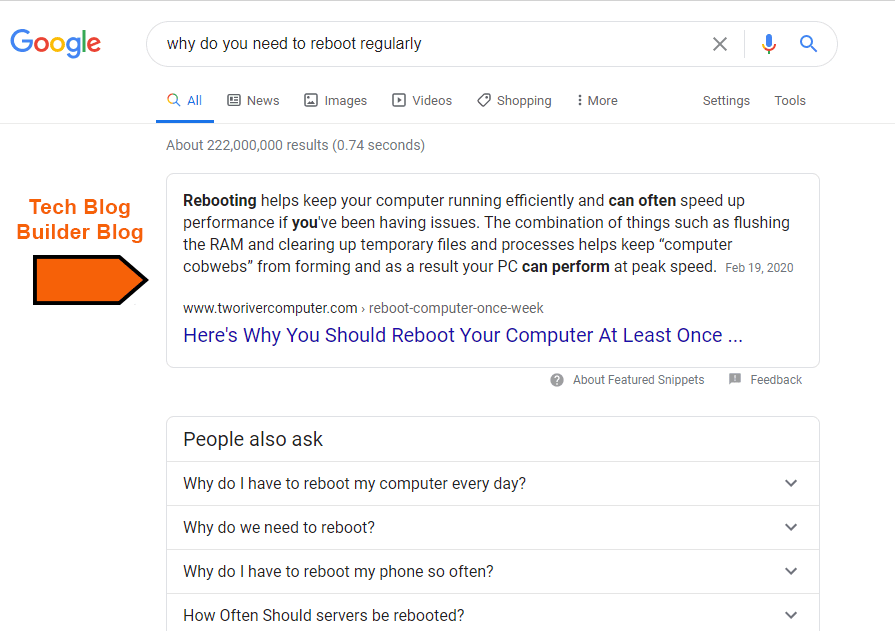
Here are some concrete ways to position your pages to get the Google equivalent of “your name in lights” in a featured snippet of your very own.
Follow Good SEO Best Practices
You want to make sure your MSP blog or website page is positioned for good SEO ranking by following all the best practices.
These include things like:
- Choose keywords to use within a page (1-3 keywords)
- Also use companion keywords
- Use all keywords naturally within the text (no stuffing!)
- Use your main keyword in the title, ALT image tags, and throughout the content
- Use headers and H1, H2, etc. tags
- Don’t make paragraphs of text too long, content should be easy to read
- Gain quality backlinks where you can
The basics of good SEO haven’t really changed much over the years. While Google does regularly tweak its algorithm, the main goal has always been the same, to deliver the best and most relevant content to searchers.
Use Question & Answer Formatting
According to Google, featured snippets are most likely to show up when the search query is in the form of a question.
You can take advantage of that by using some question and answer formatting within the content you’re writing. What you want to do is make it easy for Google’s search bot to just pick that Q&A right off your page and have it fit nicely into a featured snippet.
Take a look at this example below:
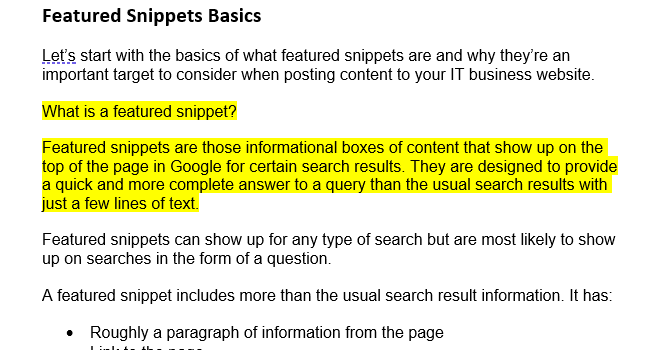
See how I threw in a question/answer format earlier in this article? That was to make it not only easier to get in a featured snippet but also to position it for that “People also ask area.”
Now, this doesn’t mean you need a ton of questions in every blog or webpage. Just use them where you can and where it makes sense. One to three in an article is plenty.
Use Numbers and Bullets
Another thing that you’ll see used often in featured snippets are lists of items. This could be in a numbered list or in bullet points. Again, this goes to readability. Google is trying to give someone a quick answer to their question that is clear and easy to read in a few seconds.
Don’t do this:
“Best practices for remote cybersecurity include using a business VPN, putting work devices on a guest network, implementing two-factor authentication, and using DNS protection.”
Do this:
“Best practices for remote cybersecurity include:
- Using a business VPN
- Putting work devices on a guest network
- Implementing two-factor authentication
- Using DNS protection”
See how the second one is much easier to read? That’s what you’re trying to achieve.
Target Your Snippet for 40-50 Words
According to SEMrush, most featured snippets that Google posts are between 40-50 words in length.
When you create a paragraph or list on your site to position for a pickup as a featured snippet, try to keep that length range in mind so it’s not too long or too short.
Optimize Your Highest-Ranking Pages for Snippets First
While pages don’t have to be the highest ranking to be picked up for a featured snippet, the better ranking pages that are already showing good SEO do have the best chance. So, it makes sense to optimize those first.
Use an SEO tool (like Ahrefs or SEMrush) to find your best ranking site pages and then optimize an area on those pages for a featured snippet.
Look for Questions Being Used in the “People Also Ask”
What type of question should you optimize your page for to give it the best chance of being picked up for a featured snippet?
Look at the “People also ask” box. That will tell you which questions Google already sees as relevant to the search query.
For example, let’s try the keyword, “how do I know if I have malware on my phone?
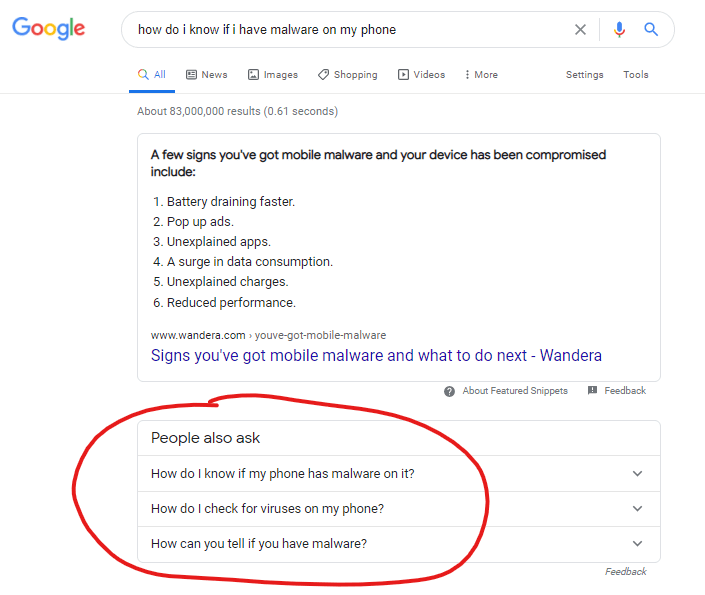
You’ll see that this result has a featured snippet in the form of a list. But you want to look at the questions and mine those for keywords to use on your page.
For example, if you have a blog about mobile malware and how to prevent it, you want to add a section that uses at least one of those questions and answers it.
You can also flip the question into an answer. i.e. using “Here is how to check for viruses on your phone” and “You can tell if you have malware by doing these things…”
Use a Relevant Image with Your Content
Webpages and blogs with images get 94% more views than those without them. A relevant image that helps tell the story of your content is going to have a better chance of being featured.
Google will often add an image along with text in a featured snippet, so it can also help your result stand out even more.
Post Well-Written, Quality Content
There’s no substitute for quality content that is well-written and relevant to readers. If a visitor lands on your page and is engaged with the content, rather than just clicking the Back button after a few seconds, your page will rank better on Google over time.
58% of marketing professionals say that original written content is their most important asset and 81% are planning to use more quality content for marketing in the future.
Google is looking for clarity and concise answers to queries which are well written. It lists some basic content principles in its webmaster guidelines:
- Make pages primarily for users, not for search engines.
- Do not deceive your users.
- Avoid tricks intended to improve search engine rankings. A good rule of thumb is whether you’d feel comfortable explaining what you’ve done to a website that competes with you, or to a Google employee. Another useful test is to ask, “Does this help my users? Would I do this if search engines didn’t exist?”
- Think about what makes your website unique, valuable, or engaging. Make your website stand out from others in your field.
By “tricks” in point three above, this means not to use things like keyword stuffing, where a keyword is used so many times that it makes the text difficult to read. Or trying to hide additional keywords by making the text white or the font size 0.
If you need help creating quality content for your website yourself, you can use an MSP blog service that can feed you original content that’s written in an SEO-friendly way.
Sticking to Best SEO Practices Can Get You Into the Spotlight
Showing up in a featured snippet boils down to continuing to post quality content that is created using SEO best practices. If you do that, you may just find your site being highlighted in that prized top spot and gaining more traffic as a result.
Do you have any questions about SEO or featured snippets? Ask us in the comments!
Speak Your Mind